Many cats spend time in shelters or in a boarding facility during their lifetime. The welfare of these cats is an issue of major concern – how can we make this experience less stressful? Stress can make cats appear less adoptable, or make them susceptible to disease, so reducing potential stressors is an important welfare question.
A new study, “The effects of social interaction and environmental enrichment on the space use, behaviour and stress of owned housecats facing a novel environment” brought to us from La Trobe University, took a stab at looking at what factors could potentially reduce stress on cats who find themselves in unfamiliar turf. The study looked at the effect of different types of resting areas, and human interaction on the cats’ stress levels and behavior. The researchers also included information about the cat: their age, sex, temperament factors, and previous experience with boarding.
Let’s start with the cats – twenty owned cats who were each assessed in the home via the Feline Temperament Profile, which measures how cats respond to a stranger on behaviors such as making eye contact, approaching the stranger, biting or scratching when handled, reaction to an unexpected noise, and willingness to interact with a toy. This gives cats one FTP score, which rates cats on friendliness, playfulness, aggressiveness, and fear. Most of the cats in the study lived in multi-cat homes, twelve were indoor-outdoor, and seven cats had previous experience being boarded in a cattery.
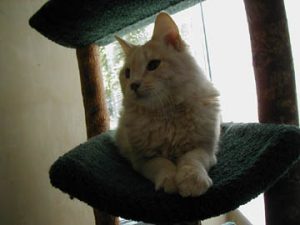 The cats were housed for two days in a room at the university, which was set up with litter box, food and water, and three enrichment options: an igloo bed, an open basket with the owner’s scent added (via used pillowcase), and a cat tree. Cats were randomly assigned to one of two groups – one group received one 20-minute visit from a human per day, and the other group received three 20-minute visits. These visits included talking in a gentle voice, as well petting, playing and grooming if the cat allowed.
The cats were housed for two days in a room at the university, which was set up with litter box, food and water, and three enrichment options: an igloo bed, an open basket with the owner’s scent added (via used pillowcase), and a cat tree. Cats were randomly assigned to one of two groups – one group received one 20-minute visit from a human per day, and the other group received three 20-minute visits. These visits included talking in a gentle voice, as well petting, playing and grooming if the cat allowed.
Several variables were recorded: each cat was given a Cat Stress Score twice a day (the CSS uses body language and activity levels to determine a cat’s stress levels); in addition, measures of “stress hormones” in the cats’ feces were taken before, during, and after the study. The proportion of time the cat spent in the enrichment options was measured, as well as time spent engaged in different behaviors (such as grooming, playing, and eating).
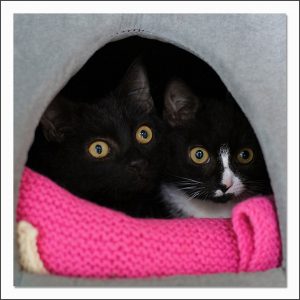
There were many variables and analyses and results, so I’ll try to focus on a few key findings. There were some individual differences when it came to enrichment use, and it seemed like it took most of the cats a day to adjust and show preferences. On the second day, cats with a higher stress score spent more time in the igloo bed; these cats were also less likely to explore, and in fact performed fewer total behaviors than less stressed cats.
Human interaction seemed to have a positive effect on stress – cats who received three visits a day had lower stress scores on day two. This suggests that human interaction for owned cats kept in confinement cat be a positive experience for them. Older cats, and cats with no previous experience being boarded also had higher stress scores.
Most cats did not sit in the open basket with their owner’s scent; this may have been because the basket was open, and not elevated, and thus was quite different in the safety it offered compared to the igloo and the cat tree. Thus, we can’t conclude that cats do NOT find owner scent comforting – further study is needed.
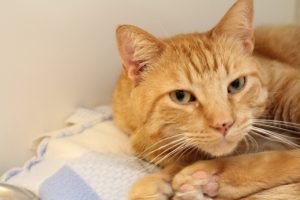
Interestingly, the Feline Temperament Profile did not predict any behaviors or stress scores. This suggests that we might need to revisit how we measure cat personality – as some shelter temperament tests are based on the FTP, and make assumptions that behaviors in one environment should predict behaviors in another. This is not the first time that the FTP has failed to correlate with other behavioral or physiological measures, although other studies have shown some consistency over time. It is possible that a longer stay in the facility in the current study would have revealed different results and more effects of the FTP.
This study did provide several tidbits of useful information that can be applied to housing cats in a shelter or cattery. Older cats may need more help adjusting to new environments; positive interactions with humans are helpful, and multiple interactions per day may be best; cats should be offered both an elevated safe place and a secure, enclosed bed to ensure meeting the needs of cats and their different tendencies to adjust to new spaces. Cats may need a day to decide which enrichment(s) they prefer, and because many cats utilized multiple enrichment items, choices may help them get comfortable. Finally, further research is needed to determine whether owner scent is helpful or calming to cats.

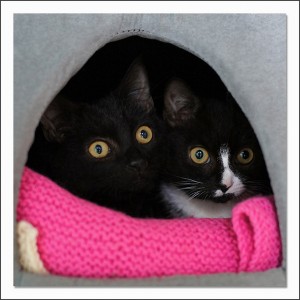
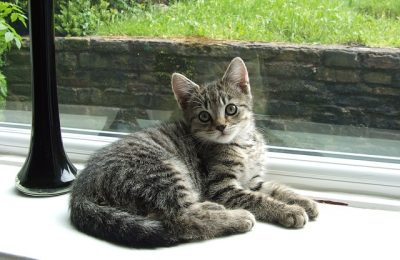
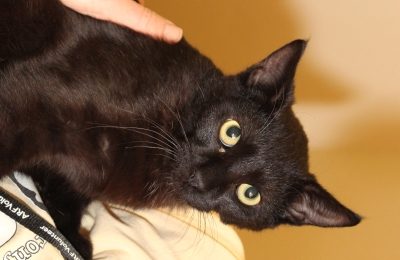
The similarity of cat behavior to humans is amazing. How about the first time a senior moves into an assisted living facility or perhaps prison.